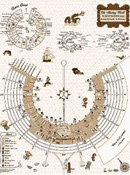 We had a great time placing theme camps in 2002. Team cohesion was the best ever, As DPW crews surveyed the city, a team of flaggers marked off the homes of the theme camps to prepare for their arrival. Working with a special set of maps, color-coded flags, and surveyor’s wheels, three teams of two set out walking the city, pushing flags into the playa to define the boundaries of every mapped camp. These placers lived and worked with the DPW for a week, completing their task faster and more efficiently than ever before. When they finished, the placement crew took over.
We had a great time placing theme camps in 2002. Team cohesion was the best ever, As DPW crews surveyed the city, a team of flaggers marked off the homes of the theme camps to prepare for their arrival. Working with a special set of maps, color-coded flags, and surveyor’s wheels, three teams of two set out walking the city, pushing flags into the playa to define the boundaries of every mapped camp. These placers lived and worked with the DPW for a week, completing their task faster and more efficiently than ever before. When they finished, the placement crew took over.
 The city is divided into seven sectors for theme camp placement. Each placer handles one sector, meeting representatives of the theme camps located there when they arrive, showing them their spaces, and introducing them to neighbors when appropriate. Radio communication from greeters to the placement team was smooth, despite the many shift changes for greeters and 16-hour days for the theme camp placement team.
The city is divided into seven sectors for theme camp placement. Each placer handles one sector, meeting representatives of the theme camps located there when they arrive, showing them their spaces, and introducing them to neighbors when appropriate. Radio communication from greeters to the placement team was smooth, despite the many shift changes for greeters and 16-hour days for the theme camp placement team.
In 2002, Black Rock City housed 445 pre-registered theme camps, including 21 villages. A total of 67 camps were placed on the Esplanade, 48 in Center Camp, 22 in Plazas (90° and 270°), and 28 in Large-Scale Sound Art (60° and 300°). The other 280 camps were located in non-Esplanade spaces. Additionally, 30 camps participated in the theme: The Floating World.
 The process of placing all those camps begins over the summer with “mapping” in which the team reviews information submitted by registering camps and assigns a placement for each on the city map. This year, mapping revealed an unexpected shortage of designated space for the registered camps in our city. We believe an increase in camp size helps to explain the shortage. Even though the number of camps that registered was a bit lower than in previous years, camps seem to be growing in population, creating a space crunch. We expanded designated theme camp space for 2002 by adding a half-block on each side, and still we had to tell several camps that we could not save space for them. This was a very difficult decision for us, as we have been all-inclusive in the past. After sending email to the theme camp announcement list, we received notice of several cancellations, which probably reduced no-shows on the playa and allowed us to map a few camps that we had thought we could not fit. Despite the crunch, reserving more space for theme camps is not in our future plans, for we believe in the importance of leaving space open as close to the playa as possible for campers who participate in other ways such as art cars, costumes, performances, playa art, non-registered theme camps, etc.
The process of placing all those camps begins over the summer with “mapping” in which the team reviews information submitted by registering camps and assigns a placement for each on the city map. This year, mapping revealed an unexpected shortage of designated space for the registered camps in our city. We believe an increase in camp size helps to explain the shortage. Even though the number of camps that registered was a bit lower than in previous years, camps seem to be growing in population, creating a space crunch. We expanded designated theme camp space for 2002 by adding a half-block on each side, and still we had to tell several camps that we could not save space for them. This was a very difficult decision for us, as we have been all-inclusive in the past. After sending email to the theme camp announcement list, we received notice of several cancellations, which probably reduced no-shows on the playa and allowed us to map a few camps that we had thought we could not fit. Despite the crunch, reserving more space for theme camps is not in our future plans, for we believe in the importance of leaving space open as close to the playa as possible for campers who participate in other ways such as art cars, costumes, performances, playa art, non-registered theme camps, etc.
At the Plazas, located at 90° and 270° on the Esplanade, keyhole-shaped clear spaces called Ports were introduced to the city this year. Each Port opened the center of the Plaza straight to the playa, offering an invitation for participants to enter the Plaza from the Esplanade. Equipped with lamp posts and burn platforms, the two Plazas experienced higher foot and bicycle traffic than ever before, and with the guidance of a new placement team member designated to manage them, they were extremely successful innovations. The theme camps placed in the Plazas were very happy with the growth of community that resulted from the attention given to them this year.
For the first time ever, the Large-Scale Sound Art camps created a community and coordinated a truly large-scale sound project. Called the Sound Tsunami, many of the systems were tuned the same radio station at a pre-determined time each day to project the sounds of the ocean to the open playa. This was an inspiring experience for those lucky enough to be out on the playa at sunset.
Future
For 2003, the placement team will be changing our familiar focus on the distinction between theme camps and villages. Our focus will turn to population and spatial needs rather than this designation of status. This change will open up the use of the terms to interpretation by participants without some restrictions that have been in place.
For 2003, we will continue our effort to achieve balance in Center Camp. The interactive element is the biggest imperative there, yet a balance needs to be struck between sound and activity during the day and at night to satisfy all of the Center Camp community.
Also for 2003, we will rework the theme camp questionnaire and the procedure for collecting camp plan documents and separate clean-up plans. With each one of almost 500 camps trying to deliver both an overall map/plan and a clean-up plan, we need to find a solution for managing almost 1,000 documents, URLs, and/or attachments. (Although we make a strong request that camps avoid sending email attachments, people still do). Between juggling the on-line questionnaire and the map and clean-up plan documents, we face serious administrative challenges. By streamlining our work, we hope to map our city even better next year.
Submitted by,
Holly Kreuter,
aka Satellite Theme Camp Coordinatrix

